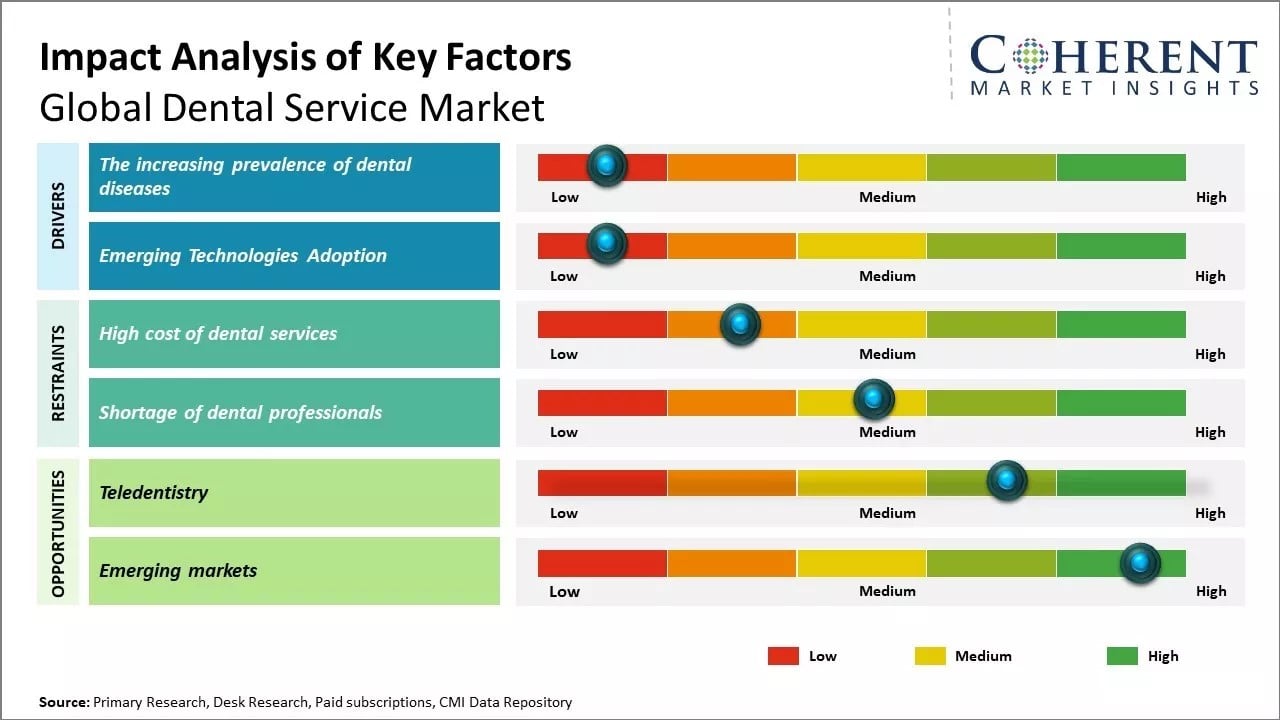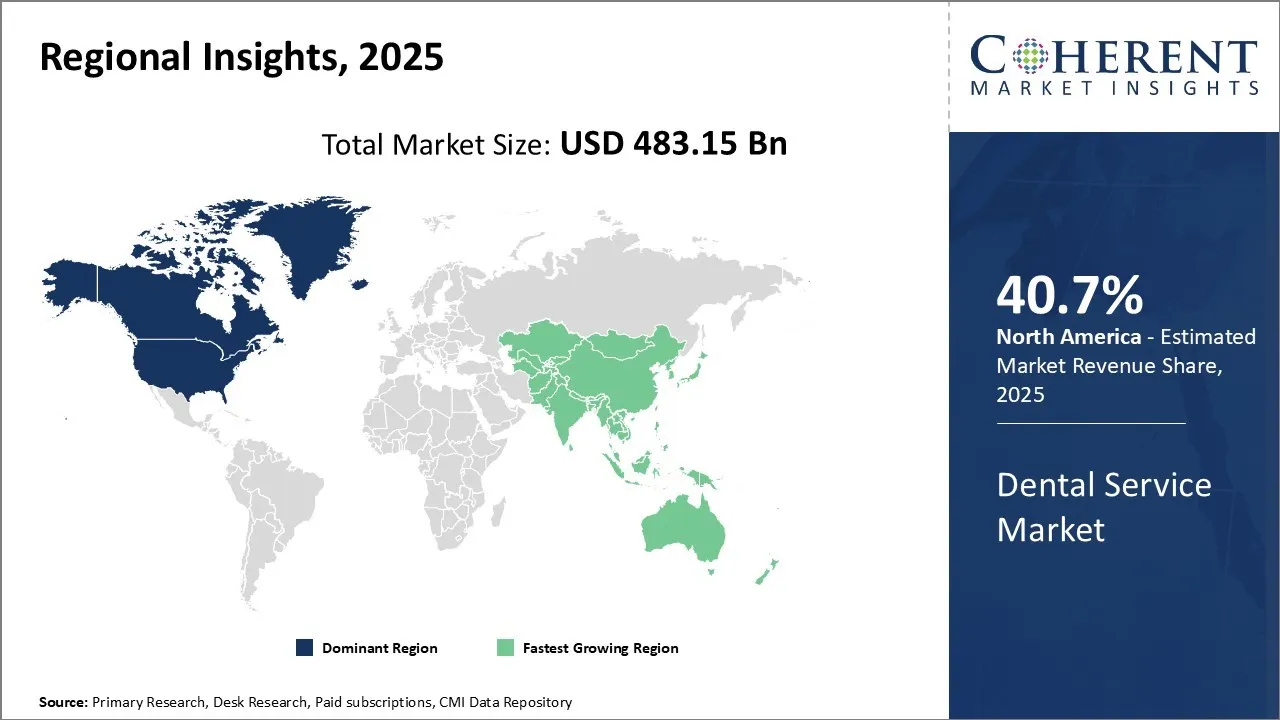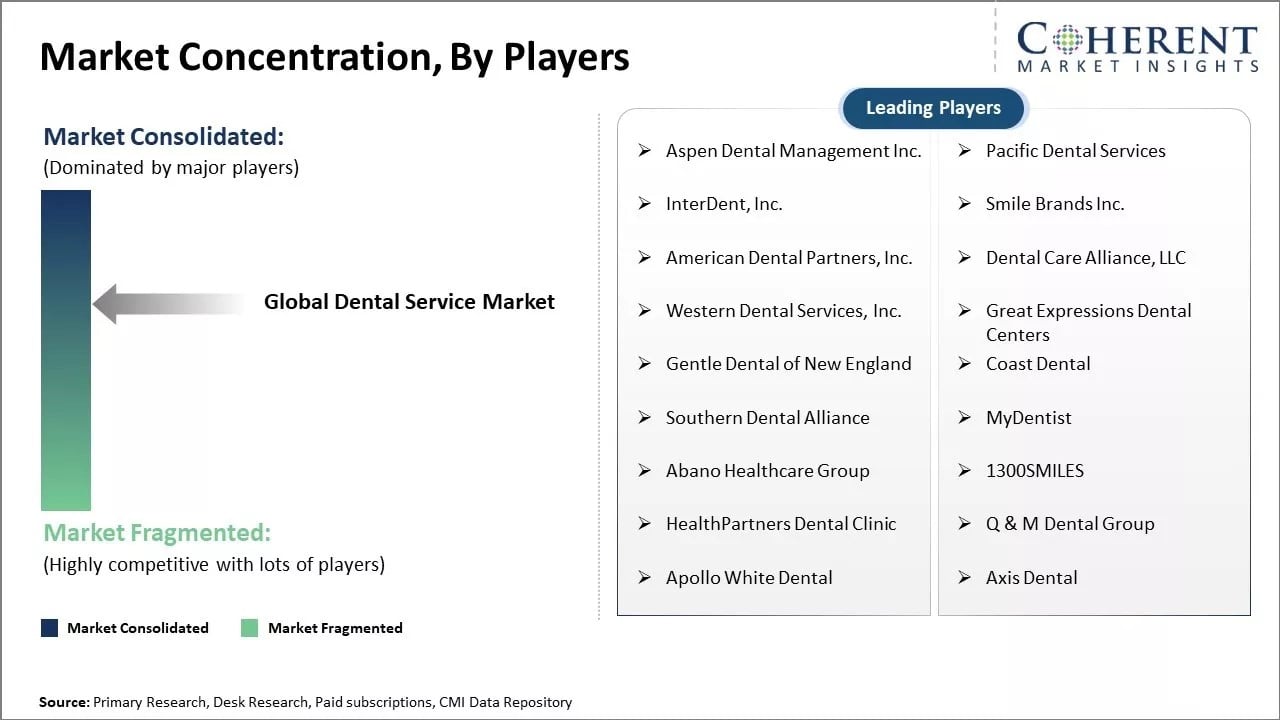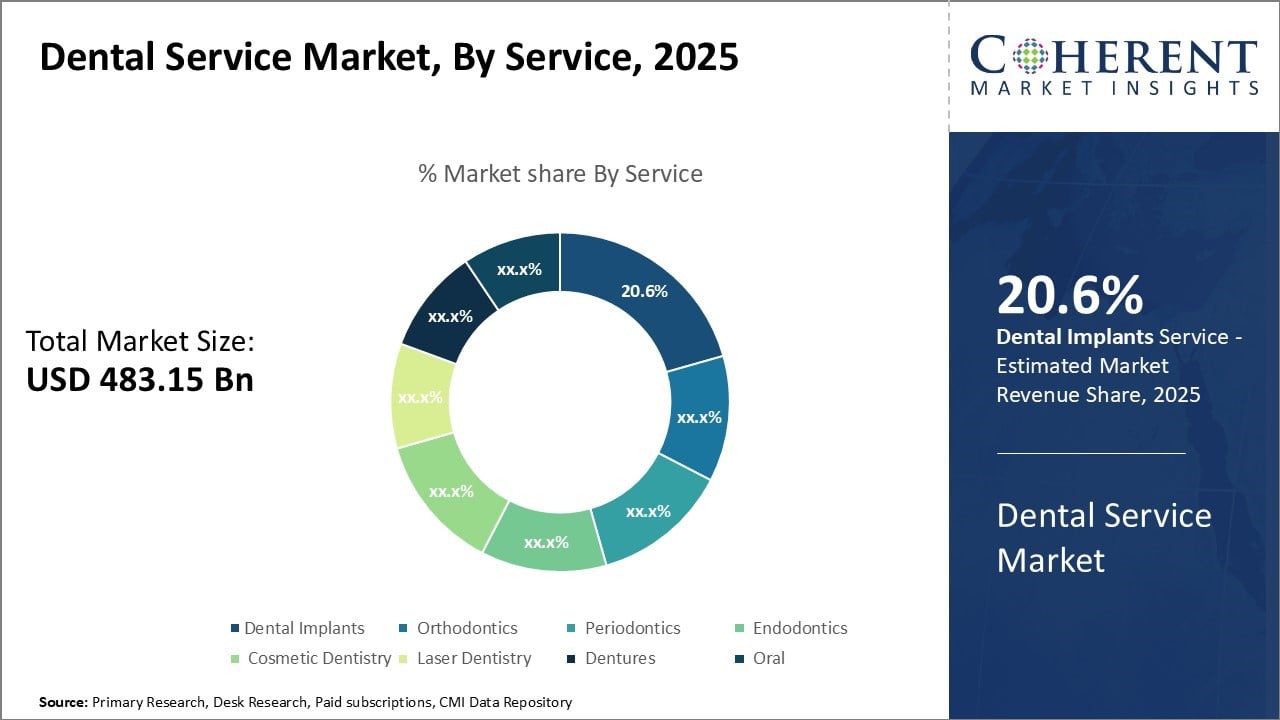Dental Service Market Size and Trends: 2025 to 2032
Global dental service market is estimated to be valued at USD 483.15 Bn in 2025 and is expected to reach USD 680.30 Bn by 2032, exhibiting a compound annual growth rate (CAGR) of 5.0% from 2025 to 2032.
Key Takeaways
- Based on Service, the Dental Implant segment is expected to lead with 20.6% share of the market in 2025, driven by demand for natural-looking, stable, and functional tooth replacements enhancing aesthetics and confidence.
- Based on End User, the Dental Clinics segment is expected to hold 60.62% share of the market in 2025, driven by high outpatient treatment volumes, convenience, and cost-effective delivery of general and specialty dental services compared to hospitals.
- Based on Region, North America is set to lead the dental service market with 40.7% share of the market in 2025. While, Asia Pacific is anticipated to be the fastest growing region.

To learn more about this report, Download Free Sample
Market Overview
Advancements in dental technology and increased awareness about oral hygiene can drive the market growth. Furthermore, rising incidence of dental diseases and growing medical tourism for dental treatments are can boost demand for dental services. The advent of new aesthetic & cosmetic dentistry procedures can also drive the market growth during the forecast period.
Current Event and Its Impact on the Dental Service Market
|
Current Event |
Description and its Impact |
|
Advanced Digital Dentistry Technology Adoption |
|
|
Regulatory Changes and Professional Practice Evolution |
|
Uncover macros and micros vetted on 75+ parameters: Get instant access to report
Role of Artificial Intelligence (AI) in Dental Services Market
The AI in Dental Services Market is growing quickly as a result of improvements in imaging, diagnostics, and treatment planning tools that use AI. AI applications make it easier and more accurate to find cavities, gum disease, and oral cancers early on. Using AI in orthodontics, implants, and cosmetic dentistry improves patient outcomes and makes the workflow more efficient. The market is growing around the world considering more people are aware of it, more people want dental services, and it is becoming part of digital dentistry platforms.
In August 2025, Laxmi Dental Limited, an Indian dental company, announced to purchase a majority stake in AI Dent to improve its digital dentistry AI capabilities. The goal of the partnership is to bring AI-powered imaging and diagnostic tools to dental offices, which will contribute to better treatment planning, accuracy, and patient care in India's dental service sector.
Dental Service Market Insights, By Service - Rising Patient Demand for Aesthetics and Functionality
In terms of service, dental implants segment is estimated to contribute the highest market share of 20.6% in 2025, owing to growing patient demand for aesthetically pleasing and functional tooth replacements. Dental implants have emerged as a preferred solution as compared to other prosthetic options like bridges or dentures as these integrate naturally with the bone and gum tissues for a realistic look and feel.
Many patients now view missing teeth not just as a dental problem but also a deterrent to their self-confidence and social interactions. Dental implants offer superior retention and stability over loose-fitting dentures, thus, preventing embarrassing slips or clicks during eating, speaking or smiling. These have a low failure rate when placed by experienced dentists using modern techniques and biomaterials. With dental implants, patients can eat whatever they want without worrying about loose or ill-fitting replacements. Their natural appearance and feel allows patients to regain their original functions without compromising aesthetics. Societal attitudes towards physical appearance and oral health can boost demand for dental implants.
For instance, in November 2025, Neocis introduced Yomi S, a new AI-powered robotic system for dental implant surgery. The advanced technology makes surgery more precise, makes planning and execution easier, and helps doctors get the same results every time. This new idea is meant to make dental implant services more efficient and better for patients, which is a step forward for digital dentistry.
Dental Service Market Insights, By End User - Growing Number of Dental Procedure Volumes
In terms of end user, dental clinics segment is estimated to contribute the highest market share of 60.62% in 2025, owing to growing number of dental treatment volumes being performed on an outpatient basis. The shift towards dental clinics rather than hospitals is driven by factors like rising self-pay opportunities, changing reimbursement models, and convenience of scheduling routine care outside the hospital setting.
Dental clinics are more focused on providing general or specialty dental services on an outpatient basis for procedures like teeth cleaning, fillings, crown & bridge work, root canals, and routine check-ups. These offer targeted treatment solutions without the additional infrastructure and operational costs associated with hospitals. Clinics can deliver high quality routine care more affordably due to streamlined overheads and billing procedures focused on out-of-pocket payers rather than insurers.
For instance, in June 2025, the Inamdar Multispeciality Hospital in Pune opened a 24/7 Dental & Face Surgery Clinic that offers emergency trauma care, advanced dental implantology, and oral-maxillofacial surgery. The facility, which is run by experienced specialists, wants to become a referral center for complicated dental and facial treatments. This are going to make it easier for people in the area to get all of the dental services they need.
Regional Insights

To learn more about this report, Download Free Sample
North America Dental Service Market Analysis & Trends
North America dominates the dental service market with an estimated market share of 40.7% in 2025. The U.S. accounts for the bulk of the market, with a highly advanced dental care system and widespread availability of private dental insurance. Americans on average spend more on dental care than citizens of other developed nations. The dental technology available in the region is also among the most advanced worldwide. Companies in this region invest heavily in R&D to develop new prosthetics, implants, cosmetic dentistry tools and other technologies. North American dental industry has a large skilled workforce pool, supported by top universities that offer specialized dental programs. This enhances the region's competitiveness in delivering complex, multispecialty dental treatments. Regulatory approval processes are also streamlined in North America, allowing for faster adoption of latest innovations in the market.
For instance, in December 2025, Mosaic Dental Collective teamed up with VideaAI to bring cutting-edge AI diagnostic technology to all of its dental clinics in the U.S. The goal of the partnership is to improve early detection accuracy, make clinical consistency better, and build patient trust. The AI platform will give dentists real-time information that will improve the quality of care and the patient experience across the network.
Asia Pacific Dental Service Market Analysis & Trends
Asia Pacific is poised to witness fastest growth in the near future. The emerging middle-class populations in China and India represent huge untapped markets potential. Unlike established Western nations, dental insurance penetration remains quite low currently across Asia. However, rapid economic development and rising disposable income is enabling more individuals to regularly visit private dental clinics and allocate greater spend on oral healthcare for preventive and aesthetic purposes. Various countries in Southeast Asia like Thailand and Malaysia have also emerged as major destinations for dental tourism, catering to international patients seeking premium dental treatments at competitive costs. The regional dental service industry is supported by significant exports from Japan, known globally for its high-quality dental equipment manufacturing prowess. Asia Pacific's large population scale and growing middle class affluence makes it the future growth engine for the international dental sector.
For instance, in May 2025, The University of Hong Kong's Faculty of Dentistry and Prince Philip Dental Hospital have opened the world's first AI-powered clinic for early detection of oral cancer in Hong Kong. The clinic uses cutting-edge AI to look at oral lesions, make early diagnoses, and help patients with potentially cancerous oral disorders get treatment quickly.
Dental Service Market Outlook Country-Wise
The U.S. Dental Service Market Trends
In 2025, the U.S. dental service market will be strong as there are more older people, more people are getting oral diseases, more people are getting implants and cosmetic dentistry, and more people are becoming aware of how important preventive oral care is. More dental clinics and insurance coverage are also helping the market grow.
For instance, in December 2025, The IDX Oral Health Microbial Testing panel from ImpetusDX is a rapid DNA-based saliva test that finds important periodontal pathogens in 24 to 48 hours. It uses PCR technology to make it easier to diagnose gum disease, help plan treatment, and customize periodontal care in dental offices.
China Dental Service Market Trends
The Chinese dental service market is seeing an abundance of growth in 2025 as more people are becoming aware of the importance of oral health, disposable incomes are rising, and more people are getting advanced dental treatments like implants and braces. The market is also growing because more private dental clinics are opening, more people are moving to cities, and the government is pushing for better oral health care.
For instance, in March 2025, At the 2025 Dental South China International Expo, Eighteeth launched its newest dental technologies, which got an immense amount of attention from dentists around the world. The company focused on new dental equipment and solutions, which led to high levels of engagement and sales. This solidified its status as a major player in the global advancement of dental services and technology adoption.
Market Report Scope
Dental Service Market Report Coverage
| Report Coverage | Details | ||
|---|---|---|---|
| Base Year: | 2024 | Market Size in 2025: | USD 483.15 Bn |
| Historical Data for: | 2020 To 2024 | Forecast Period: | 2025 To 2032 |
| Forecast Period 2025 to 2032 CAGR: | 5.0% | 2032 Value Projection: | USD 680.30 Bn |
| Geographies covered: |
|
||
| Segments covered: |
|
||
| Companies covered: |
Aspen Dental Management Inc., Pacific Dental Services, InterDent, Inc., Smile Brands Inc., American Dental Partners, Inc., Dental Care Alliance, LLC, Western Dental Services, Inc., Great Expressions Dental Centers, Gentle Dental of New England, Coast Dental, Southern Dental Alliance, MyDentist, Abano Healthcare Group, 1300SMILES, HealthPartners Dental Clinic, Q & M Dental Group, Apollo White Dental, Axis Dental |
||
| Growth Drivers: |
|
||
| Restraints & Challenges: |
|
||
Uncover macros and micros vetted on 75+ parameters: Get instant access to report
Dental Service Market Driver
Increasing prevalence of dental diseases
Increasing prevalence of dental diseases can drive the global dental service market growth. With changing lifestyles and diet patterns, there has been increase in diseases related to oral health in the recent few years. Poor nutrition and excessive consumption of sugar and carbohydrate rich foods has led to higher incidence of dental caries or cavities among both children and adults alike across the world.
Furthermore, as per the same source above, severe periodontal or gum disease affects around 10-15% of adults aged between middle age to older age globally. With more people experiencing dental issues at younger age, there has been huge demand for advanced dental treatment and preventive services. Dental clinics and hospitals are focusing on providing wide range of services from routine dental cleaning, checkups, dental X-rays to major restorative procedures like root canals, crowns, bridges and dental implants.
Advanced technologies like CAD/CAM systems for dental prosthetics, 3D CT scanning and cone-beam imaging, laser dentistry and intra-oral cameras are being increasingly adopted by dental practitioners to offer enhanced patient experience and better treatment outcomes. Growing cosmetic dentistry market has also boosted the revenue for dental service providers. More individuals are opting for aesthetic procedures like teeth whitening, veneers, bonding to improve physical appearance.
Adoption of emerging technologies
Technology has brought exciting developments in dental industry, from upgraded instruments to advanced materials. Dentists are levering digital solutions for precise diagnosis, customized treatment planning, and streamlined workflows. Cone Beam Computed Tomography or 3D CBCT imaging allows examination of complex cases in three dimensions without need for multiple appointments. Computer-Aided Design or CAD techniques and 3D printing enable creation of accurate models and personalized restorations in-office to reduce turnaround times. Digitization has increased access to virtual dental care also through tele-dentistry especially for people in remote areas or those needing periodic check-ups across borders. Wider usage of laser dentistry, intra-oral cameras, imaging software and CAD/CAM setups in prosthodontics and implant planning have elevated quality of dental services. Furthermore, laser dentistry facilitates painless procedures like cavity detection and gum treatments. Such cutting-edge technologies provide minimally invasive treatments in short time as compared to manual approaches.
Market Concentration and Competitive Landscape

To learn more about this report, Download Free Sample
Analyst Opinion (Expert Opinion)
- The market for dental services is steadily growing due to additional individuals want preventive, restorative, and cosmetic procedures. Orthodontics, endodontics, periodontics, and preventive care are some of the most important service categories in the market. Endodontics, in particular, makes up a large part of service revenues. Cosmetic dentistry is one of the fastest-growing areas because more and more patients care about aesthetic outcomes.
- Independent dental practices still provide most of the services, but dental service organizations (DSOs) are growing quickly, which helps with standardizing care and making operations more efficient. Payment trends show that private dental insurance pays for a large part of services, which makes it easier for more people to get elective and preventive care.
- North America is still the market's primary contributor because it has a lot of procedures, good infrastructure, and full insurance coverage. At the same time, Asia-Pacific is becoming the fastest-growing region because incomes are rising, the middle class is growing, and people are more willing to pay for dental care. Countries like India are seeing a lot of growth, especially in cosmetic dentistry and implant surgery.
- Using new technologies like digital imaging and AI-assisted diagnostics is making clinical outcomes and efficiency better. When DSOs buy other companies, they strengthen provider networks even more, giving them more power to negotiate with payers and suppliers. Overall, the dental services market is strong and growing. It is set up for long-term growth thanks to a wider range of procedures, more insurance coverage, and new technologies.
Dental Service Market Opportunities
Teledentistry
Teledentistry offers a great opportunity for the global dental service market growth. Teledentistry refers to the use of telehealth technologies to provide dental care services remotely. Teledentistry enables dentists to diagnose, recommend treatment options, and prescribe medications for patients without requiring an in-person visit through the use of audio and visual communication technologies. This reduces burden on dental clinics and allows patients, especially those in remote and underserved areas, to access dental experts virtually.
Dental Service Industry News
- In December 2025, A startup connected to the University of Toronto has made a dental "smart" gum with ingredients that fight germs, reduce inflammation, and remineralize teeth to help keep your mouth clean when you need to brush. The product is being introduced in U.S. dental clinics, with plans for clinical trials and wider adoption, enhancing daily dental care options.
- In November 2025, The Indian dental tech company epikdoc released epikdoc Pro and a Patient LLM tool to make AI-based dental decision-making better. The platforms help doctors by using AI to analyze X-rays, get second opinions, and integrate workflows. The goal is to improve the accuracy of diagnoses, patient care, and the efficiency of operations in dental clinics and labs across the country.
- In April 2024, Dr. Donian Shen, a leading implant dentist in Mountain View, S., introduced Smile By Design, a premier dental practice offering cosmetic, restorative, and general dentistry services. The practice specializes in restoring missing teeth through dental implants and improving smile aesthetics with porcelain veneers.
- In December 2023, Pacific Dental Services, a prominent dental and medical support organization in the U.S., announced the opening of Culver Smiles Dentistry in partnership with MemorialCare, a healthcare system in the U.S. This marks a significant milestone as the inaugural co-located dental-medical practice, uniting a national dental support organization with a regional healthcare leader.
Market Segmentation
- Service Insights (Revenue, USD Bn, 2025 - 2032)
- Dental Implants
- Orthodontics
- Periodontics
- Endodontics
- Cosmetic Dentistry
- Laser Dentistry
- Dentures
- Oral & Maxillofacial Surgery
- Others
- End User Insights (Revenue, USD Bn, 2025 - 2032)
- Hospitals
- Dental Clinics
- Regional Insights (Revenue, USD Bn, 2025 - 2032)
- North America
- U.S.
- Canada
- Latin America
- Brazil
- Argentina
- Mexico
- Rest of Latin America
- Europe
- Germany
- U.K.
- Spain
- France
- Italy
- Russia
- Rest of Europe
- Asia Pacific
- China
- India
- Japan
- Australia
- South Korea
- ASEAN
- Rest of Asia Pacific
- Middle East
- GCC
- Israel
- Rest of Middle East
- Africa
- South Africa
- North Africa
- Central Africa
- Key Players Insights
- Aspen Dental Management Inc.
- Pacific Dental Services
- InterDent, Inc.
- Smile Brands Inc.
- American Dental Partners, Inc.
- Dental Care Alliance, LLC
- Western Dental Services, Inc.
- Great Expressions Dental Centers
- Gentle Dental of New England
- Coast Dental
- Southern Dental Alliance
- MyDentist
- Abano Healthcare Group
- 1300SMILES
- HealthPartners Dental Clinic
- Q & M Dental Group
- Apollo White Dental
- Axis Dental
Sources
Primary Research Interviews
- Dental Service Providers (Clinics, Chains, and Individual Practices)
- Dental Equipment Manufacturers & Distributors
- Dental Lab Technicians and Service Providers
- Oral Health Consultants & Advisors
- Healthcare Technology & IT Solutions Providers in Dentistry
- Others
Databases
- Bloomberg Terminal
- Thomson Reuters Eikon
- IHS Markit
- Euromonitor International
- S&P Global Market Intelligence
- Others
Magazines
- Dental Economics
- Dental Products Report
- Inside Dentistry
- Dentistry Today
- Others
Journals
- Journal of Dental Research
- International Journal of Dental Hygiene
- Journal of Clinical Dentistry
- Dental Materials Journal
- Others
Newspapers
- Financial Times
- The Wall Street Journal
- Reuters
- Bloomberg News
- Others
Associations
- World Dental Federation (FDI)
- American Dental Association (ADA)
- European Dental Association (EDA)
- International Association for Dental Research (IADR)
- Others
Public Domain Sources
- U.S. National Institute of Dental and Craniofacial Research (NIDCR)
- World Health Organization (WHO) – Oral Health
- European Commission – Health & Food Safety Directorate
- World Bank Open Data (Healthcare & Dental Metrics)
- Centers for Disease Control and Prevention (CDC) – Oral Health Data
- Others
Proprietary Elements
- CMI Data Analytics Tool
- Proprietary CMI Existing Repository of Information for the Last 8 Years
*Definition: Global dental service market consists of dental practices, clinics and hospitals that offer a range of diagnostic, preventive, restorative, cosmetic and surgical services to patients for various dental health conditions. This market caters to both general dental care needs as well as specialized dental needs. It involves services related to dental exams, cleaning, filling cavities, root canals, dental implants, crowns, bridges, dentures, extractions, orthodontics and other advanced cosmetic procedures.
Share
Share
About Author
Manisha Vibhute is a consultant with over 5 years of experience in market research and consulting. With a strong understanding of market dynamics, Manisha assists clients in developing effective market access strategies. She helps medical device companies navigate pricing, reimbursement, and regulatory pathways to ensure successful product launches.
Missing comfort of reading report in your local language? Find your preferred language :
Transform your Strategy with Exclusive Trending Reports :
Frequently Asked Questions
EXISTING CLIENTELE
Joining thousands of companies around the world committed to making the Excellent Business Solutions.
View All Our Clients


